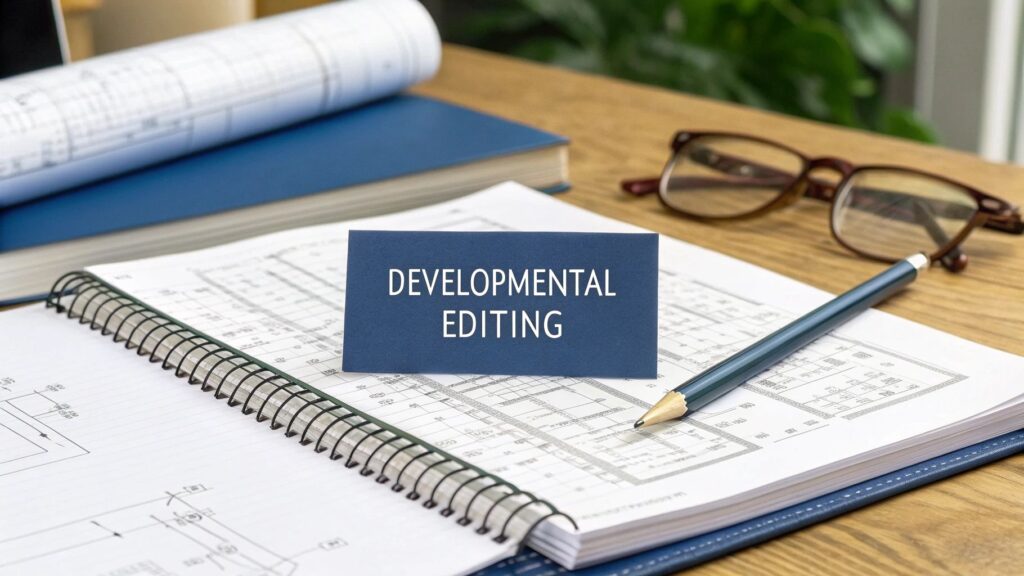Think of developmental editing as the very first, and arguably most important, pass an editor takes on your manuscript. It’s not about commas or spelling; it’s about the heart and soul of your story. This is where we look at the big picture, the fundamental structure that holds everything together.
It's a bit like an architect reviewing the blueprints for a house. Before anyone even thinks about paint colors or light fixtures, the architect makes sure the foundation is solid, the rooms flow logically, and the overall design is sound. You wouldn't want to build a house with a shaky foundation, would you? The same goes for your book.
What Is Developmental Editing, Really?
Imagine you’ve poured your heart into a draft, but the plot has a few holes, a key character's motivation feels a bit fuzzy, and the pacing drags in the middle. These aren't minor issues; they're structural problems that can prevent a reader from ever finishing your book.
This is where a developmental editor comes in. They act as your story's architect, diving deep into the core elements to make sure they work. They aren't there to fix your grammar; they're there to stress-test your story's foundation.
A good developmental editor will ask you some tough but crucial questions:
- Is your main conflict compelling enough to carry the entire story?
- Are your characters’ journeys believable? Do they grow and change in a way that feels earned?
- Does the ending feel satisfying and resolve the promises you made to the reader at the beginning?
The Big-Picture Perspective
This focus on the "big picture" is precisely what sets developmental editing apart from other stages like copyediting or proofreading. Those come much later, once the story itself is locked in. You don't polish the windows on a house that's about to be torn down and rebuilt.
The real goal here is to take a manuscript that has a spark of potential and shape it into a powerful, cohesive narrative. It's all about making sure the story works before you start worrying about making the sentences pretty.
This stage is absolutely essential, especially for longer works like a novel or a detailed non-fiction book. While writers have always relied on feedback, developmental editing became a formal, recognized role in publishing around the mid-20th century. If you're curious, you can explore more about the evolution of editing in the publishing market to see how these specialized roles developed over time.
Ultimately, a developmental editor gives you a strategic roadmap for your revisions. They help you see your own work with fresh eyes, identify the foundational weaknesses, and empower you to build a story that will truly resonate with readers.
What a Developmental Editor Actually Fixes
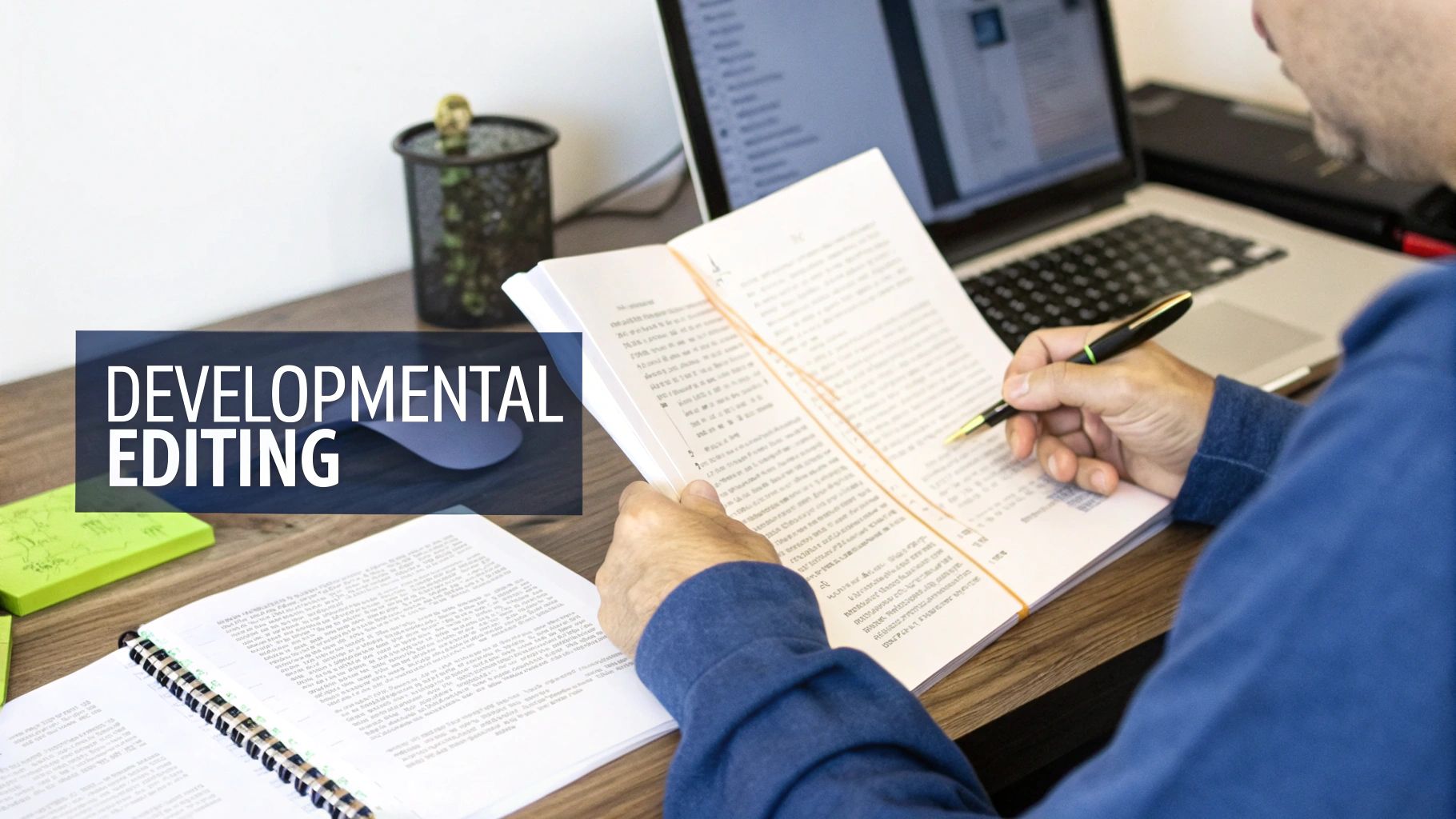
So, what does a developmental editor do on a practical level? Think of your manuscript as the architectural blueprint for a house. The developmental editor is the master builder who comes in to review that blueprint, not to pick out paint colors, but to make sure the foundation is solid and the walls won't collapse.
They're stress-testing the very core of your work to catch major structural problems before you waste time polishing sentences in a chapter that might need to be cut. This big-picture focus is a crucial early step in the https://barkerbooks.com/book-writing-process/, ensuring the story you're telling is sound from the ground up.
Plot and Structure
First up is your story's skeleton. A developmental editor will hunt for gaping plot holes, confusing timelines, and story beats that just don't add up. Does the inciting incident really kick things off, or does it fizzle? Is the climax a satisfying explosion or a disappointing pop?
They'll also look at your narrative structure as a whole. It doesn't matter if you're using a classic three-act structure or something more unconventional; the editor’s job is to ensure all the pieces connect logically, build suspense, and give the reader a powerful payoff.
Character Development
Characters are the soul of your story, but do they actually feel alive? A developmental editor gets into the nitty-gritty of each major character's journey. They're looking for believable motivations, consistent actions, and—most importantly—meaningful change.
For instance, if your cautious, rule-following hero suddenly robs a bank without any clear reason, it yanks the reader right out of the story. An editor flags these jarring moments, suggesting ways to ground the character's choices in their established personality, making their transformation feel earned and deeply human.
A developmental edit ensures your characters feel like real people with authentic desires and flaws, not just pawns moving through a plot. Their transformation must feel both believable and necessary to the story.
Pacing and Flow
Pacing is all about the rhythm of your storytelling. Even a brilliant plot can fall flat if it drags on during boring parts or rushes through the moments readers have been waiting for. It's a delicate balance.
Your editor reads specifically for this rhythm, pinpointing areas where the story feels sluggish or, conversely, moves too fast for the reader to absorb what’s happening. They might suggest:
- Trimming scenes that don't push the plot forward or reveal something new about a character.
- Expanding moments by adding more detail or internal thought to give key events the emotional weight they deserve.
- Reordering chapters to create better suspense or control how and when the reader gets crucial information.
A solid pacing strategy is what keeps a reader hooked from page one to the very end. The best writing always starts with a plan, and understanding how this type of editing aligns with broader content strategy services can make the entire publishing journey much smoother.
World-Building and Theme
Finally, an editor looks at the world you've built and the core ideas you're exploring. In a fantasy or sci-fi novel, this means checking for consistency—do the rules of your magical system or futuristic society hold up? In any genre, it’s about making the setting feel real and immersive.
They also dig into your theme. What’s the central question or message at the heart of your book? A good editor helps you weave that theme subtly through the plot and character arcs, so it resonates with the reader instead of feeling like a lecture. This is what gives a good story a lasting, profound impact.
4 Key Differences: Developmental Editing vs. Other Editing Types
New authors often get tangled up in editing jargon. Developmental editing, line editing, copyediting, proofreading… what’s the difference? And does the order even matter?
It absolutely does. Getting the editing stages mixed up is like trying to paint a house before the foundation is even poured. It’s a surefire way to waste a lot of time and money.
Think of it like building that house. Each type of editor is a different specialist, and you need to bring them in at the right time to make sure your book is structurally sound, beautifully finished, and ready for readers to move in.
The Architect vs. The Interior Designer
The editing journey has a natural flow, moving from the big picture down to the tiniest details.
- Developmental Editing: This is your book's architect. The developmental editor isn't worried about comma placement; they're looking at the manuscript's blueprint. They examine the plot, character arcs, pacing, and overall structure to make sure the story stands strong. This has to happen first.
- Line Editing: Once the architecture is solid, the interior designer steps in. The line editor works sentence by sentence, honing your unique voice, sharpening your prose, and making sure the language flows beautifully from one paragraph to the next.
The Inspector vs. The Final Walkthrough
With the core structure and style in place, it's time for the technical checks.
- Copyediting: Think of this as the building inspector. A copyeditor is the expert who meticulously checks the "wiring and plumbing" of your writing. They hunt down errors in grammar, spelling, and punctuation, ensuring everything is up to code.
- Proofreading: This is the final walkthrough right before you hand over the keys. Just before the book goes to print, a proofreader does one last sweep to catch any lingering typos or weird formatting glitches that everyone else missed.
It's crucial to understand how these roles differ. For a deeper dive, you can explore more about proofreading vs editing and how each fits into the publishing puzzle.
Developmental Editing vs Other Editing Stages
To make it even clearer, here’s a simple table that breaks down the four major editing stages.
| Editing Type | Primary Focus | When It Happens | Main Goal |
|---|---|---|---|
| Developmental Editing | Big-picture story elements (plot, characters, pacing) | First draft stage | Ensure the core story is compelling and structurally sound. |
| Line Editing | Style, voice, flow, and sentence-level prose | After developmental edits | Make the writing artistic, clear, and engaging. |
| Copyediting | Grammar, spelling, punctuation, and consistency | After line edits | Correct technical errors and ensure consistency. |
| Proofreading | Typos and formatting errors | Final manuscript | Catch any remaining errors before publication. |
This quick comparison shows exactly where each editor focuses their expertise.
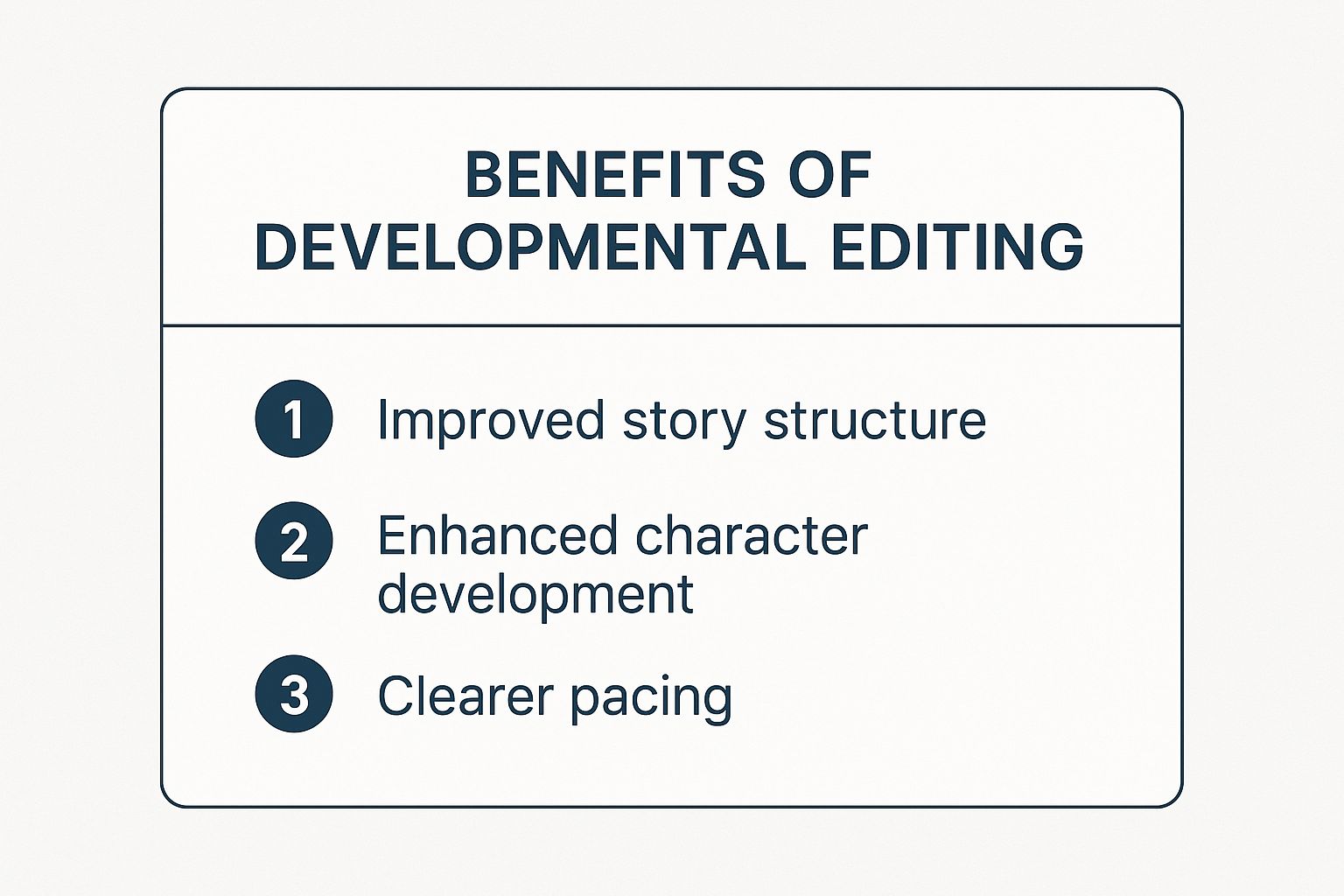
As you can see, the biggest benefits of a strong developmental edit all point back to the story's foundation—its structure, characters, and rhythm. When you know what developmental editing is and where it fits, you can invest your resources wisely and turn a promising rough draft into a book that truly resonates with readers.
Why Investing in Developmental Editing Pays Off
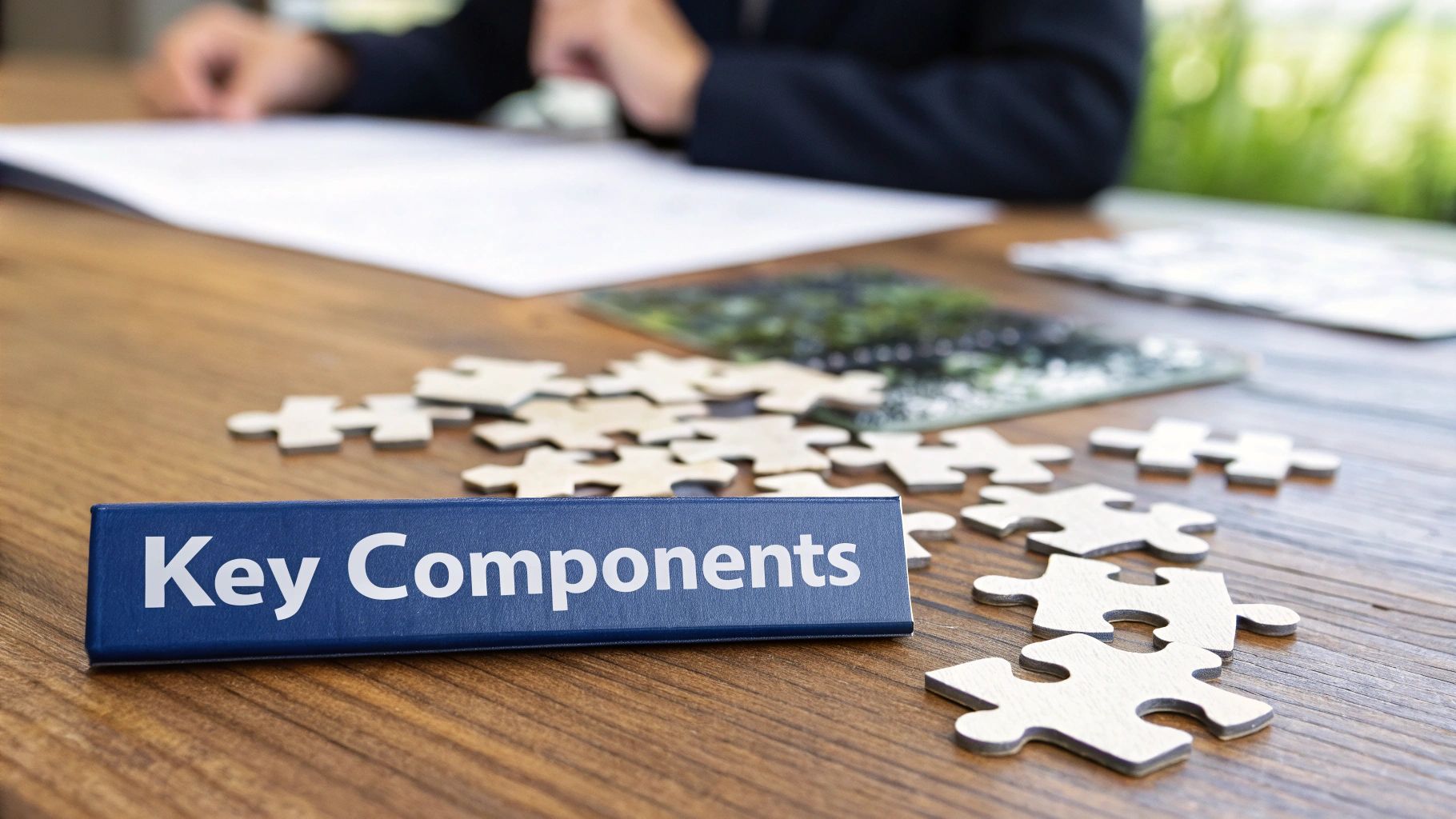
It’s easy to see developmental editing as just another line item on a long list of publishing expenses. But that’s a common misconception. A better way to look at it is as a fundamental investment in your manuscript’s future. This isn't just about spending money—it's about giving your story its best shot in a crowded marketplace.
Think of all the time and frustration you'll save. By addressing deep-seated issues like plot holes, pacing problems, or flimsy character motivations right from the start, you avoid the agony of massive rewrites later on. It’s like building a house; you have to get the foundation right before you can even think about the paint and trim.
The Tangible Returns of a Stronger Story
A manuscript that has been through a developmental edit is simply a more marketable product. It’s been refined to deliver a powerful, cohesive experience that resonates with readers. When a story provides the emotional punch people are looking for, it directly influences how well it’s received.
This isn’t just wishful thinking; the results are concrete. We know that approximately 45% of self-published authors invest in developmental editing to elevate their work. What’s more, an industry study found that 38% of these projects undergo significant structural changes that dramatically boost reader engagement. This often leads to an increase in sales by 20-35% within the first six months of launch. You can learn more about the market impact of editing to see how quality translates to commercial success.
Investing in developmental editing isn't just about fixing a manuscript—it's about building a reputation. A well-structured, satisfying book leads to better reviews, stronger word-of-mouth recommendations, and a loyal readership.
Building Confidence and Your Writing Career
Beyond the book itself, working with a good developmental editor is a huge boost to your own confidence. It validates the core of your idea while giving you a clear, actionable roadmap to make it even better. That expert partnership can transform the overwhelming task of revision into a structured, manageable, and even exciting, process.
Ultimately, this investment pays dividends across your entire writing career. Each book you write builds your reputation. When you start with a professionally polished story, you’re not just launching a book; you’re laying the groundwork for long-term growth as an author. The benefits ripple outwards:
- Improved Reader Satisfaction: A tight, satisfying narrative keeps readers turning pages and leaves them genuinely excited for your next release.
- Stronger Author Platform: Great reviews and positive buzz are the best tools for building a dedicated fanbase.
- Enhanced Craft: The insights you gain from a developmental editor are lessons in storytelling you’ll carry with you to every future project.
Navigating the Developmental Editing Process
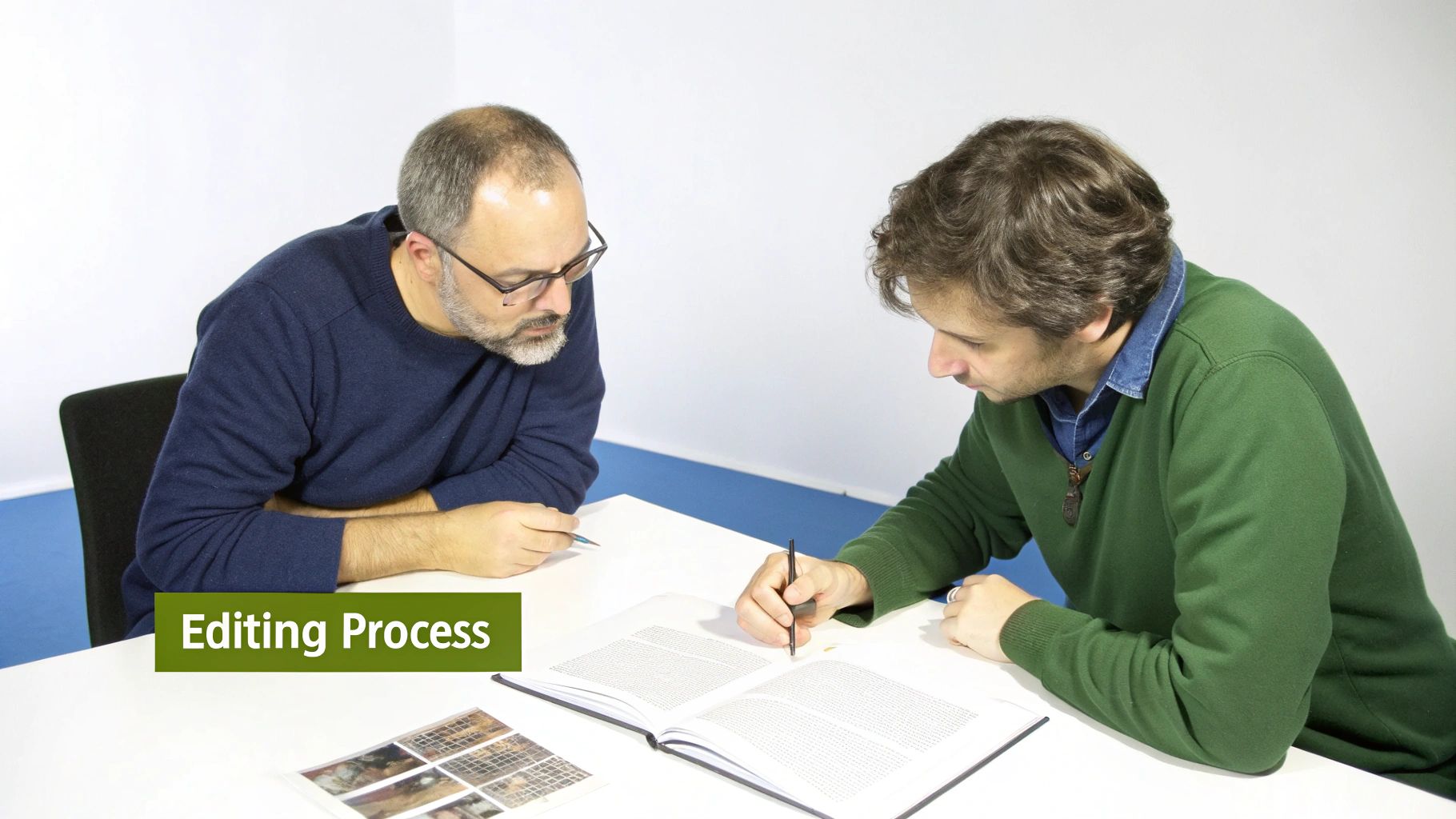
Knowing what developmental editing is and actually going through the process are two very different things. When you hire a developmental editor, you’re not just handing over your draft for a quick fix. You’re kicking off a creative partnership. Think of your editor as a guide who’s there to help you find the absolute best version of your story.
Everything usually starts with an initial chat. This is where you’ll lay it all out—what your manuscript is about, your vision for it, and any nagging worries you might have. This conversation is crucial. It lets the editor grasp what you’re trying to achieve and gives you the confidence that they're the right person for the job. Being open and clear here builds the trust needed for a great working relationship.
The Deep Dive and Analysis
Once you’re on the same page and ready to go, the real work begins for the editor. They'll start what’s known as a "deep-dive read." This isn't a casual skim. They'll likely read through your manuscript multiple times, meticulously analyzing every foundational piece of your story.
At this stage, they're not reading for fun; they're dissecting the very architecture of your narrative. They're looking at plot, character arcs, pacing, world-building, and whether your themes hold up from start to finish.
As they read, they’re asking some tough questions:
- Does the first chapter really grab the reader and set up what's at stake?
- Is the midpoint a genuine turning point that escalates the conflict, or does it fall flat?
- Are there any subplots that feel like dead ends, pulling focus from the main story?
- Does the ending provide a satisfying and believable resolution to everything you've set up?
Your Roadmap for Revision
After this intensive analysis, you’ll get two critical things back from your editor. Together, they create a clear roadmap for your revisions. The first is the editorial letter. This is a detailed document, often 10-20 pages long, that breaks down the editor's big-picture feedback. It’ll celebrate your story's strengths while also pinpointing its major areas for improvement, offering clear strategies to tackle them.
The editorial letter is your blueprint for revision. It won’t just tell you what isn’t working; a good letter will explore why it isn't working and offer concrete, actionable suggestions for fixing it.
The second part of the package is the collection of in-manuscript comments. These are notes and suggestions made directly in your manuscript file, pointing to specific sentences, paragraphs, or scenes. For instance, if the editorial letter mentioned an inconsistent character voice, the comments will highlight the exact lines where that voice stumbles.
This powerful combination of macro-level guidance from the letter and micro-level examples in the comments gives you a complete toolkit to confidently dive into your next draft.
Finding the Right Editor for Your Book
Choosing a developmental editor is a huge decision. Think of it less like hiring a contractor and more like bringing on a creative partner for your most important project. The right person can help your manuscript reach its full potential, while the wrong fit can lead to frustration and a story that never quite finds its footing.
So, where do you begin your search? Start with places where the pros hang out. Reputable industry directories are your best bet. Vetted platforms like the Editorial Freelancers Association (EFA) or Reedsy are fantastic resources because they allow you to browse profiles, filter by genre, and read reviews from other authors. It’s a great first step to ensure you’re looking at qualified candidates.
Evaluating Potential Candidates
Once you've built a shortlist, it's time to do some homework. Dig into their portfolios and see what kinds of books they've actually worked on. You want to find someone with proven experience in your genre. An editor who's a wizard with historical romance probably isn't the best choice for your gritty sci-fi epic. Their background has to match your story's DNA.
Next, set up a call or video chat. This is your chance to get a feel for them as a person and ask some critical questions beyond what's on their website.
- How would you describe your editing philosophy?
- What does your typical process and timeline look like?
- How do you deliver feedback? (Is it a long editorial letter, in-line comments, or both?)
- What are your rates and how does payment work?
Pay close attention to their communication style. You're about to go on a long journey together toward becoming a published author, and you need a guide you can trust and communicate with openly.
The single most important step in this entire process is asking for a sample edit. Have your top candidates review a small portion of your manuscript, usually around 5-10 pages. This is the only way to truly know if their style clicks with yours.
Seriously, don't skip this step. A sample edit gives you a direct preview of how they work and think. It ensures you find someone who not only understands the craft of developmental editing but who also genuinely gets your story and your vision for it.
Finding this kind of expert matters. The global market for content editing is booming and expected to surpass $4 billion by the end of the decade. As more authors seek professional guidance, you can learn more about the growth of content editing services to understand why securing the right partner is such a valuable investment.
Got Questions About Developmental Editing? Let's Get Them Answered.
Dipping your toes into the world of professional editing can feel a little overwhelming, almost like you're learning a new language. To clear things up and help you feel more confident, we’ve put together answers to the questions we hear most often from authors trying to figure out if developmental editing is the right move for them.
How Much Does Developmental Editing Typically Cost?
This is usually the first thing on every author's mind, and for good reason. The truth is, rates can be all over the map. They really depend on the editor's experience level, how long your manuscript is, and how much work it needs.
Most editors charge by the word, with a common range falling between $0.02 and $0.05 per word. Others might quote you a flat fee for the entire project. For a standard-length novel, you're looking at a significant investment, often somewhere between $1,500 and $5,000, and sometimes more. Always, always get a detailed quote and a signed contract before you commit to anything.
Should I Get a Developmental Edit Before or After Beta Readers?
This is a great question. We almost always recommend getting the developmental edit done before your manuscript goes out to beta readers. Think of it this way: a developmental editor is like an architect for your story. They’re there to fix the fundamental structure—shoring up plot holes, fixing wonky pacing, and making sure your characters feel real and consistent.
By tackling these foundational issues first, you're setting your beta readers up for success. They can then give you feedback on what it's like to simply experience the story, instead of getting tripped up by structural problems that a professional could have helped you solve. Their feedback becomes much more valuable.
Can I Just Developmentally Edit My Own Manuscript?
Every writer needs to learn how to self-edit—it’s a non-negotiable skill. But when it comes to a developmental edit, you really need a fresh, objective pair of eyes. It is incredibly difficult, if not impossible, to spot the big-picture flaws in a world you've spent months or years creating.
As the author, you know what you intended to put on the page. A developmental editor, on the other hand, only sees what's actually there. That professional distance is exactly what you’re paying for; it's the key to uncovering and fixing the deep-seated issues you're too close to see.
What's the Difference Between an Editorial Letter and a Manuscript Critique?
While they sound similar, they're quite different services. The editorial letter is the main event of a full developmental edit. It's your comprehensive roadmap for revision, often running 10 or more pages long. It dives deep into your story's strengths and weaknesses and gives you concrete, actionable strategies for making it better.
A manuscript critique, by contrast, is a higher-level overview. It’s shorter, usually around 3-8 pages, and points out the major problem areas but doesn't go into the same prescriptive detail on how to fix them. A developmental edit is a much deeper, more hands-on service designed to guide your revisions.
Ready to turn your manuscript into a professionally published book that captivates readers worldwide? At BarkerBooks, we provide end-to-end support, from expert developmental editing to global distribution. Discover how our team can help you achieve your publishing dreams today.
